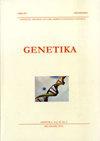A novel variation of gamt in cerebral creatine deficiency syndrome, first complete homozygous deletion of GAMT
4区 农林科学
Q3 Agricultural and Biological Sciences
引用次数: 0
Abstract
Cerebral Creatine Deficiency Syndromes (CCDS) are congenital metabolic disorders in the creatine metabolism pathway. In this study, we evaluated the clinical, phenotypic, radiological and genetic features of patients with CCDS. We tried to identify early diagnosis clues in patients. Especially, we reviewed the causes of delay in patients with late diagnosis. In line with these findings, the diagnosis is confirmed by enzyme tests and next generation sequencing based whole genome sequencing. In this study, 6 patients whose diagnosis was genetically confirmed were presented (5 GAMT mutations (someone is complete homozygous deletion in GAMT gene), 1 SLC6A8 mutation). 5 of these patients were from the same family, and 4 patients were patients with a late diagnosis. Two of the 4 patients who were diagnosed late were moderate and two had severe phenotype. The neurological findings consisted of patients with different clinical findings such as speech disorder, cognitive retardation, autism and epilepsy. Patients received appropriate treatment for the type of cerebral creatine deficiency. While response to treatment was good in early diagnosed cases, a partial clinical improvement was detected in cases diagnosed late. The patient, who was started treatment before neurological symptoms appeared, was neurodevelopmentally normal. It was observed that there was a strong relationship between age at diagnosis and phenotype and prognosis. We compared the clinical findings, phenotype and genotype characteristics of patients with CCDS. We reviewed the causes of delay in patients with late diagnosis. Thus, we wanted to raise awareness about early diagnosis and treatment of CCDS, one of the rare metabolic diseases.脑肌酸缺乏综合征中gamt的新变异,gamt首次完全纯合缺失
脑肌酸缺乏综合征(CCDS)是肌酸代谢途径中的先天性代谢障碍。在这项研究中,我们评估了CCDS患者的临床、表型、放射学和遗传学特征。我们试图在病人身上找到早期诊断的线索。特别是,我们回顾了延迟诊断患者的原因。根据这些发现,诊断是由酶测试和下一代测序为基础的全基因组测序证实。本研究中出现6例经遗传学确诊的患者(5例GAMT突变(有人GAMT基因完全纯合缺失),1例SLC6A8突变)。5例患者来自同一家庭,4例患者为晚期诊断患者。4例晚期确诊患者中2例为中度表型,2例为重度表型。神经学的研究结果包括不同临床表现的患者,如语言障碍、认知障碍、自闭症和癫痫。脑肌酸缺乏症患者接受相应的治疗。虽然早期诊断的病例对治疗的反应良好,但在诊断较晚的病例中发现了部分临床改善。患者在神经系统症状出现前开始治疗,神经发育正常。观察到,诊断年龄与表型和预后有很强的关系。我们比较了CCDS患者的临床表现、表型和基因型特征。我们回顾了延迟诊断患者的原因。因此,我们希望提高对CCDS这一罕见代谢性疾病的早期诊断和治疗的认识。
本文章由计算机程序翻译,如有差异,请以英文原文为准。
求助全文
约1分钟内获得全文
求助全文
来源期刊

Genetika-Belgrade
AGRONOMY-GENETICS & HEREDITY
CiteScore
1.80
自引率
0.00%
发文量
1
审稿时长
6-12 weeks
期刊介绍:
The GENETIKA is dedicated to genetic studies of all organisms including genetics of microorganisms, plant genetics, animal genetics, human genetics, molecular genetics, genomics, functional genomics, plant and animal breeding, population and evolutionary genetics, mutagenesis and genotoxicology and biotechnology.
 求助内容:
求助内容: 应助结果提醒方式:
应助结果提醒方式:


